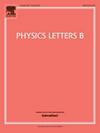[公式略]Ne中介子张量力对α聚类的影响
IF 4.5
2区 物理与天体物理
Q1 ASTRONOMY & ASTROPHYSICS
引用次数: 0
摘要
核聚簇作为一种受强相互作用支配的量子相变现象,表现出对核力的特定特征高度敏感的特征。在这里,我们研究了核变形和张量力如何影响轻核中α-团簇的形成。利用轴向变形相对论Hartree-Fock-Bogoliubov模型研究了20Ne原子核在基态和激发态下的聚类结构。得到了不同四极变形下的核结合能和典型单粒子能级,揭示了嵌入π-赝向量(π-PV)耦合Fock图中的张量力的作用。虽然变形引起了简并球面轨道的水平分裂,但介子交换张量力提供了一个额外的贡献,在延长的情况下增加了它们。相应的,由于非中心张量相互作用,超变形长态的激发能降低,导致预测值更接近20Ne的2α衰变模式的参考阈值。然后通过核定位功能表征了20Ne中可能的α-聚类构型。尽管对基态的贡献相对较小,但在超变形长态激发态中,π介子张量力显著改变了密度分布和核子局域化,这一点通过表征球形基分量中的水平混合得到进一步证明。发现介子张量力通过其长程吸引,通过平衡库仑斥力来抵消团簇的溶解。因此,结果揭示了张量力在核簇的形成、定位和稳定性中的额外作用,与核变形演变的单粒子水平相关。本文章由计算机程序翻译,如有差异,请以英文原文为准。
Impact of pion tensor force on alpha clustering in 20Ne
The nuclear clustering, as a quantum phase transition phenomenon governed by strong interactions, exhibits characteristics that are highly sensitive to the specific features of nuclear forces. Here, we examine how nuclear deformation and tensor forces influence -cluster formation in light nuclei. The axially deformed relativistic Hartree-Fock-Bogoliubov model is utilized to investigate the clustering structure of the Ne nucleus, at both the ground state and the excited state with a superdeformed prolate. The nuclear binding energies and the canonical single particle levels are obtained at different quadrupole deformation, and the role of tensor force embedded in the Fock diagram of -pseudovector (-PV) coupling is revealed. While the deformation induces level splittings from the degenerate spherical orbits, the pion-exchanged tensor force provides an additional contribution that increases them in the prolate case. Correspondingly, the excitation energy in the superdeformed prolate state is reduced due to the noncentral tensor interaction, leading to a predicted value which is much closer to the referred threshold for the decay mode of Ne. Possible -clustering configurations in Ne are then characterized by examining the nucleonic localization function. Although the contribution to the ground state is relatively small, the density profile and nucleonic localization are significantly changed by the pion tensor force for the superdeformed prolate excited state, as further evidenced by characterising the level mixing in the spherical basis components. It is found that the pion tensor force, through its long-range attraction, counteracts cluster dissolution by balancing against Coulomb repulsion. Thus, the results reveal the extra role of the tensor force, correlated to the evolved single-particle levels with nuclear deformation, in the formation, localization and stability of nuclear clustering.
求助全文
通过发布文献求助,成功后即可免费获取论文全文。
去求助
来源期刊

Physics Letters B
物理-物理:综合
CiteScore
9.10
自引率
6.80%
发文量
647
审稿时长
3 months
期刊介绍:
Physics Letters B ensures the rapid publication of important new results in particle physics, nuclear physics and cosmology. Specialized editors are responsible for contributions in experimental nuclear physics, theoretical nuclear physics, experimental high-energy physics, theoretical high-energy physics, and astrophysics.
 求助内容:
求助内容: 应助结果提醒方式:
应助结果提醒方式:


